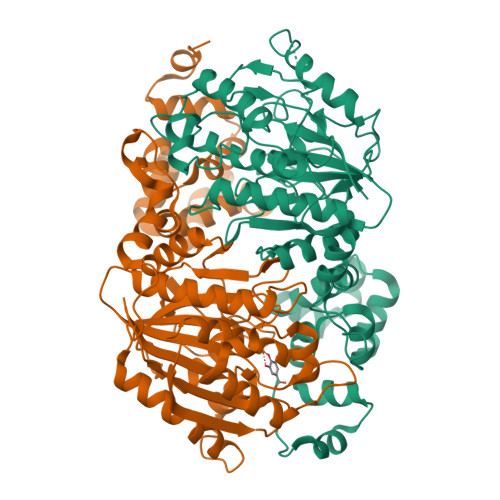Molecular Mechanism of Strict Substrate Specificity of an Extradiol Dioxygenase, DesB, Derived from Sphingobium sp. SYK-6
Sugimoto, K., Senda, M., Kasai, D., Fukuda, M., Masai, E., Senda, T.(2014) PLoS One 9: e92249-e92249
- PubMed: 24657997
- DOI: https://doi.org/10.1371/journal.pone.0092249
- Primary Citation of Related Structures:
3WKU, 3WPM, 3WR3, 3WR4, 3WR8, 3WR9, 3WRA, 3WRB, 3WRC - PubMed Abstract:
DesB, which is derived from Sphingobium sp. SYK-6, is a type II extradiol dioxygenase that catalyzes a ring opening reaction of gallate. While typical extradiol dioxygenases show broad substrate specificity, DesB has strict substrate specificity for gallate. The substrate specificity of DesB seems to be required for the efficient growth of S. sp. SYK-6 using lignin-derived aromatic compounds. Since direct coordination of hydroxyl groups of the substrate to the non-heme iron in the active site is a critical step for the catalytic reaction of the extradiol dioxygenases, the mechanism of the substrate recognition and coordination of DesB was analyzed by biochemical and crystallographic methods. Our study demonstrated that the direct coordination between the non-heme iron and hydroxyl groups of the substrate requires a large shift of the Fe (II) ion in the active site. Mutational analysis revealed that His124 and His192 in the active site are essential to the catalytic reaction of DesB. His124, which interacts with OH (4) of the bound gallate, seems to contribute to proper positioning of the substrate in the active site. His192, which is located close to OH (3) of the gallate, is likely to serve as the catalytic base. Glu377' interacts with OH (5) of the gallate and seems to play a critical role in the substrate specificity. Our biochemical and structural study showed the substrate recognition and catalytic mechanisms of DesB.
Organizational Affiliation:
Department of Materials Chemistry, Asahikawa National College of Technology, Asahikawa, Hokkaido, Japan.


















